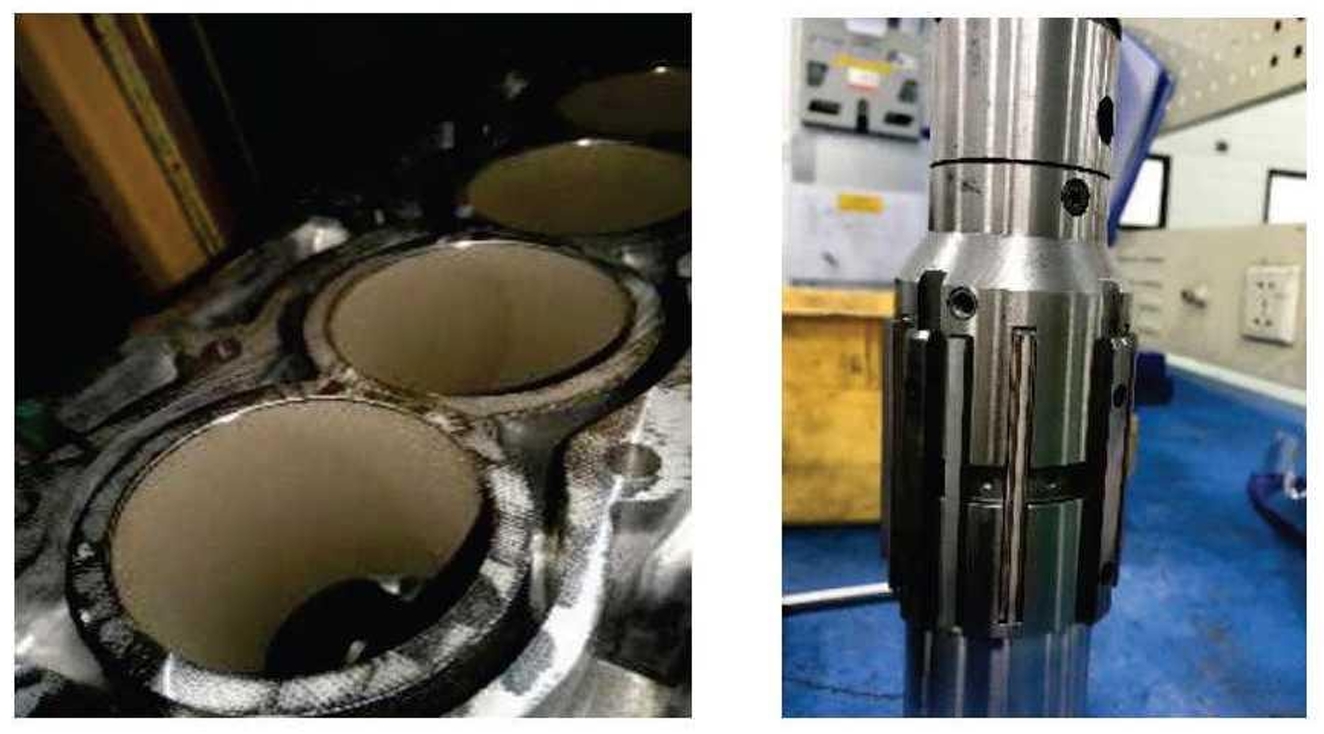Abstract
In the automotive industry, the shift toward lightweight and high-performance engines has driven the adoption of advanced technologies such as bore spray coating. This innovation replaces traditional cast iron liners with a 0.2 mm ultra-hard coating (400 HV) applied directly to the engine block’s cylinder bores. While this coating enhances wear resistance and thermal conductivity, its extreme hardness poses significant challenges for honing processes. Traditional polycrystalline diamond (PCD) honing tools, which previously achieved a lifespan of 50,000 cycles on cast iron liners, now last only 500 cycles on spray-coated engine blocks, increasing costs by 100-fold. This paper details the development of a novel honing tool formulation tailored for spray-coated engine blocks, achieving superior quality and extended tool life. The optimized tools are now widely implemented in HIR K2 engine block production.

1. Introduction
The automotive industry is transitioning toward hybrid and electric vehicles, yet internal combustion engines (ICEs) will remain dominant during this transitional phase. To meet stringent emissions and efficiency standards, engine block technologies must evolve. Bore spray coating, a “black technology” developed by our team, eliminates heavy cast iron liners, reducing engine block weight by 2 kg per unit. The 0.2 mm coating improves thermal conductivity, minimizing heat loss and fuel consumption. However, its 400 HV hardness—four times higher than cast iron—renders traditional honing tools ineffective. This paper addresses the challenges of honing ultra-hard coatings and presents a breakthrough in honing tool design.
2. Principles of Honing
Honing is a precision machining process that creates crosshatch patterns on cylinder bores to optimize lubrication and sealing. During honing, the engine block is fixed on a honing machine, and the honing head rotates while reciprocating axially. Abrasive grains on the honing tools act as cutting edges, removing material to achieve desired surface finish and geometry.
Key Forces in Honing
The honing force FF is derived from circumferential (FminFmin) and axial (FmaxFmax) components:F=F=Fmin=f⋅cos(θ2)⋅AFmin=f⋅cos(2θ)⋅AFmax=f⋅sin(θ2)⋅AFmax=f⋅sin(2θ)⋅A
Where:
- ff: Cutting coefficient (0.2–0.3)
- AA: Honing tool contact area (mm²)
- θθ: Crosshatch angle (°)
3. Composition of Honing Tools
Honing tools consist of abrasive grains and a binding agent. The balance between tool hardness and self-sharpening determines performance.
3.1 Abrasive Materials
Common abrasives include aluminum oxide, cubic boron nitride (CBN), and PCD. PCD, with unmatched hardness, is ideal for ultra-hard engine block coatings. Trials compared domestic and imported abrasives (Table 1).
Table 1: Performance of Abrasives from Different Suppliers
| Supplier | Abrasive Type | Result |
|---|---|---|
| Huangtong | JX-D700F-M2-300 III | 302 cycles, bore scratches |
| Zhongnan | JX-D700F-M2-300 ZN | 680 cycles, bore scratches |
| GE | JX-D700F-M2-300 GE | 1,080 cycles, tool depletion |
Imported GE abrasives outperformed domestic alternatives due to uniform grain size. However, their 1,080-cycle lifespan remained insufficient.
3.2 Binding Agents
Binding agents secure abrasive grains while enabling self-sharpening. Metal binders (e.g., copper, tin, aluminum) dominate due to superior grain retention. Initial trials with Japanese/US-supplied tools highlighted cost and monopoly issues, driving domestic R&D.
4. Development of Honing Tool Formulation
4.1 Initial Formulations
Early attempts focused on adjusting metal-ceramic ratios. For example:
Formulation 1:
- 40% Cu, 20% Al, 20% Sn, 10% Ag, 10% ceramic
- Result: 600 cycles, bore scratches.
Formulation 2:
- 40% Cu, 15% Al, 20% Sn, 10% Ag, 15% ceramic
- Result: 200 cycles, V-shaped tool damage.
Formulation 3:
- 40% Cu, 10% Al, 20% Sn, 10% Ag, 20% ceramic
- Result: 3 cycles, severe bore scratches.
4.2 Breakthrough with Graphite Additive
Introducing graphite as a non-metallic dispersant improved self-sharpening:
Formulation 4:
- 54% Cu, 21% Sn, 15% Al, 10% graphite
- PCD concentration: 35%
- Result: 3,476 cycles, no defects.
Formulation 5 (Optimized):
- 54% Cu, 21% Sn, 15% Al, 10% graphite
- PCD concentration: 50%
- Result: 6,232 cycles.
Formulation 6 (Final):
- 55% Cu, 22% Sn, 16% Al, 7% graphite
- PCD concentration: 35%
- Result: 7,018 cycles, surpassing Japanese tools.
5. Sintering Process Optimization
Sintering parameters critically influence tool durability. The baseline process included:
- Ramp-up: 1–5 min, 400°C, 70 kN
- Temperature hold: 5–10 min, 800°C, 70 kN
- Stabilization: 10–18 min, 800°C, 70 kN
- Cool-down: 18–22 min, 400°C, 70 kN
Table 2: Sintering Trials
| Trial | Modification | Result (Cycles) |
|---|---|---|
| 1 | Extended hold time (+2 min) | 6,982 |
| 2 | Increased pressure (90 kN) | 3,098 |
| 3 | Reduced temp (700°C + 2 min) | 8,986 |
Trial 3 achieved an 8,986-cycle lifespan, demonstrating that moderate temperature reduction enhanced binder homogeneity.
6. Cost Reduction and Application
Domestic honing tools reduced costs significantly:
Table 3: Cost Comparison Before and After Optimization
| Parameter | Japanese Tools | Domestic Tools |
|---|---|---|
| Unit cost (¥) | 700 | 320 |
| Lifespan | 3,000 cycles | 8,960 cycles |
| Cost/engine (¥) | 5.60 | 0.86 |
Annual savings for 400,000 HIR K2 engine blocks: ¥1.896 million.
7. Conclusion
- Abrasive Selection: Imported PCD abrasives ensure consistency, but domestic formulations with graphite additives achieve superior performance.
- Binding Agent: Optimized Cu-Sn-Al-graphite blends balance hardness and self-sharpening.
- Sintering: Lowering peak temperature to 700°C improves binder uniformity, extending tool life.
- Cost Efficiency: Domestic tools reduce costs by 85%, breaking foreign monopolies.
This advancement enables efficient machining of ultra-hard spray-coated engine blocks, supporting the automotive industry’s transition to high-performance, lightweight engines.
